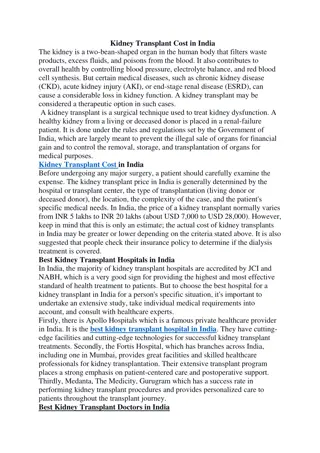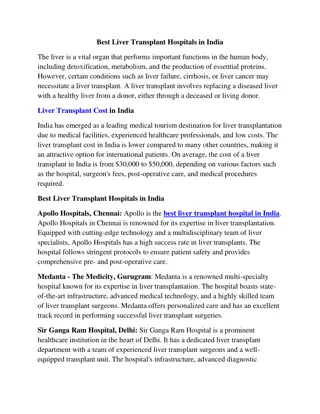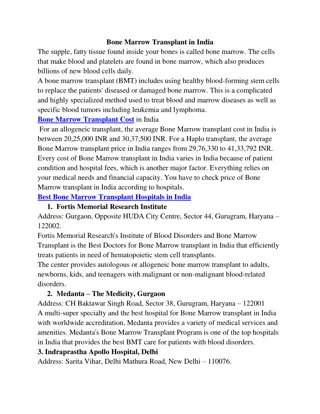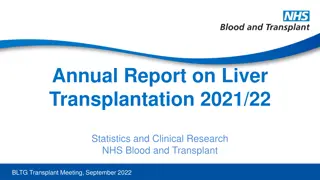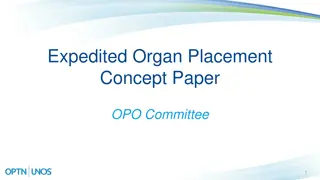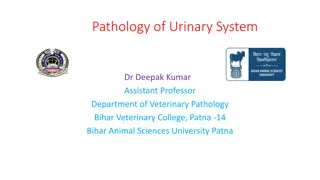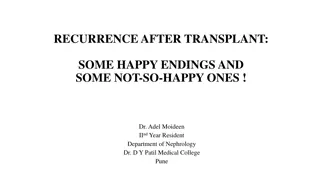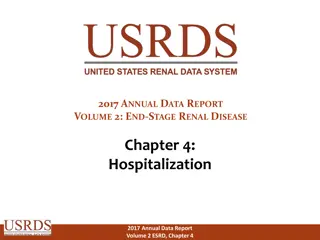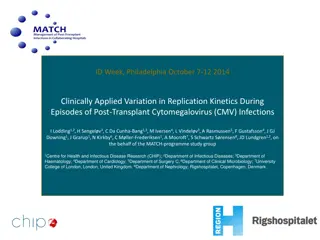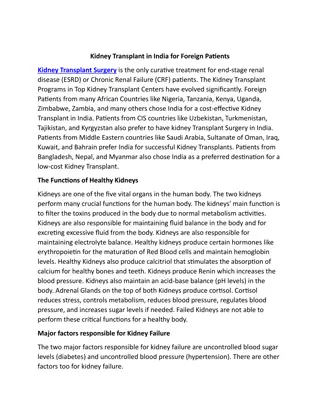Deteriorating Renal Function in Renal Transplant Patients
A case-based exploration of infectious complications post-renal transplant, focusing on pathogen identification, manifestations, and management. Discusses common pathogens and their implications on renal function.
Download Presentation

Please find below an Image/Link to download the presentation.
The content on the website is provided AS IS for your information and personal use only. It may not be sold, licensed, or shared on other websites without obtaining consent from the author.If you encounter any issues during the download, it is possible that the publisher has removed the file from their server.
You are allowed to download the files provided on this website for personal or commercial use, subject to the condition that they are used lawfully. All files are the property of their respective owners.
The content on the website is provided AS IS for your information and personal use only. It may not be sold, licensed, or shared on other websites without obtaining consent from the author.
E N D
Presentation Transcript
35 y/o M with ESRD due to Streptococcal GN develops fever and chills 5 days s/p renal transplant. Current medications include tacrolimus, mycophenolate mofetil, and prednisone. Vitals: T 102F, P 118, RR 18, BP 166/94. Exam: notable for palpable transplant kidney and slight erythema at the edges but without drainage. Labs: WBC 14.5, Creatinine 1.8
Which of the following pathogens is most likely causing this patient s current findings? A. Aspergillus fumigatus B. Staphylococcus aureus C. Cryptococcus neoformans D. Cytomegalovirus E. Influenza virus
41 y/o M s/p cadaveric renal transplant (CMV D-/R-) 4 months ago for ESRD is seen in follow up. Current medications include tacrolimus, mycophenolate mofetil, and prednisone. He is asymptomatic with good urine output. Physical examination- transplant kidney is palpable and nontender. Labs: WBC 6, Hgb 12.8, Plt 220, BUN 43, creatinine 2.8, UA (+protein, RBCs, WBCs with transitional cells containing intranuclear inclusions), urine cx -
Which of the following organisms is most likely causing this patient s deteriorating renal function? A. Polyomavirus BK B. Polyomavirus JC C. Human herpesvirus-6 D. Cytomegalovirus E. Human papilloma virus
90% of the population is seropositive Ubiquitous Does not cause disease in immunocompetent Latent in renal tubular epithelial cells Timeline: usually 1 year after transplant Manifestations: Hemorrhagic cystitis Ureteral stenosis BK-induced nephropathy
Hemorrhagic cystitis: Incidence: 10-25% bone marrow transplant patients Supportive care Ureteral stenosis: Primarily renal transplant patients Supportive care, urologic intervention BK-induced nephropathy: Incidence: Up to 10% of renal transplant patients Sx: asymptomatic hematuria, increasing creatinine 1-10% cases lead to irreversible graft failure Dx: urine and blood BK virus PCR, renal biopsy Tx: reduction in immunosuppression
What pathogens are patients at risk for? Encapsulated Streptococcus pneumoniae Haemophilus influenzae Neisseria meningitidis Capnocytophaga canimorsus Babesia
26 y/o M with hx HIV is evaluated for a sudden widespread eruption of skin lesions. His last office visit was 1 year ago when his CD4 count was 50. At that time, bactrim, azithromycin, and highly active antiretroviral therapy were initiated, but the patient discontinued them and did not follow up until today. PE: temp 101F, cachectic; skin findings are widely disseminated but concentrated on face, scalp, and neck- 2- to 5-mm umbilicated papules with surrounding erythema.
Which of the following is the most likely diagnosis? A. Cytomegalovirus B. Disseminated cryptococcal infection C. Herpes simplex virus infection D. Mycobacterium avium complex
Clinical syndromes: Pulmonary Variable presentation Pulmonary nodules or fulminant pneumonia Cerebromeningitis Most common cause of fungal meningitis Cryptococcus is highly neurotropic Fever, headache, meningismus, vision changes, abnormal mentation, seizures Cryptococcomas Parenchymal lesions C gattii > C. neoformans Cutaneous lesions- nodular Chorioretinitis, vitritis, ocular nerve invasion www.cdc.gov
A 57 y/o M with history of advanced cirrhosis consumed raw oysters in Louisiana. He develops severe diarrhea, abdominal pain, high grade fever, and a blistering dermatitis requiring hospitalization. He developed septic shock and died within 48 hours. http://ts3.mm.bing.net/th?id=H.4775360642744622w=253h=181c=7rs=1pid=1.7 ????
57 y/o M originally from SE Asia who underwent a liver transplant (CMV D+/R+). Immunosuppression includes tacrolimus, MMF, and high dose prednisone. Two months later, he develops acute respiratory distress, a rash, and sepsis with GNR bacteremia. A tracheal aspirate revealed the following:
Which of the following organisms is most likely responsible for the respiratory failure and GNR sepsis? A. Ascaris B. Trichinosis C. Entamoeba histolytica D. Strongyloides
Clinical findings: Larva currens Pulmonary syndrome Eosinophilia Abdominal pain & diarrhea Pearls: Association with HTLV-1 GNR sepsis GNR meningitis Hyperinfection syndrome Treatment: ivermectin Dx: Stool examination Serology
50 y/o F presents with acute onset of dyspnea and dry cough that have rapidly worsened over the past 3 days. The patient underwent liver transplantation 15 months ago. Current therapy consists of sirolimus, azathioprine, prednisone, and inhaled pentamidine. Allergic to sulfa. PE: temp 101.1F, BP 140/80, P 110, RR 23. Arterial oxygen saturation is 83% on ambient air. Pulmonary examination reveals scattered fine crackles bilaterally. CBC, BUN, creatinine, and UA normal. CXR with slight, diffuse, increased opacities bilaterally. Chest CT with bilateral diffuse, fine alveolar and interstitial infiltrates. A sputum cannot be obtained.
Which of the following is the most likely cause of this patient s findings? A. Aspergillus fumigatus B. Candida glabrata C. Pneumocystis jirovecii D. Staphylococcus aureus E. Streptococcus pneumoniae
What are the options for PJP prophylaxis? Trimethoprim-sulfamethoxazole Dapsone Atovaquone Inhaled pentamidine Who requires PJP prophylaxis?
25 y/o WF with hx of AML underwent an allogeneic bone marrow transplant (CMV D+/R+) 4 months ago. She develops fever, malaise, and severe diarrhea. Blood, stool, and urine cultures are all negative. A colonoscopy reveals:
Which of the following organisms is most likely the cause of colitis? A. Cytomegalovirus B. Polyomavirus JC C. Clostridium difficile D. Campylobacter E. Epstein-Barr virus
Clinical manifestations: CMV syndrome= most common presentation Presence of CMV in blood and Fever and One of more of the following: malaise, leukopenia, atypical lymphocytosis, thrombocytopenia, elevated LFTs Tissue invasive CMV disease Evidence of CMV in biopsy and Signs and symptoms Hepatitis, colitis, and pneumonitis= most common
Diagnosis: Serum CMV PCR A negative PCR does not rule out tissue invasive disease Tissue biopsy with evidence of virus Treatment: Ganciclovir Valganciclovir Foscarnet
A 54 year old man with chronic obstructive pulmonary disease (COPD) develops a new respiratory infection marked by blood-tinged sputum. A chest radiograph shows a ball-like mass in a preexisting right upper lobe cavity. What is the most likely diagnosis? a. b. c. d. Candida pneumonia Aspergilloma Cryptococcoma Pneumocystis pneumonia


